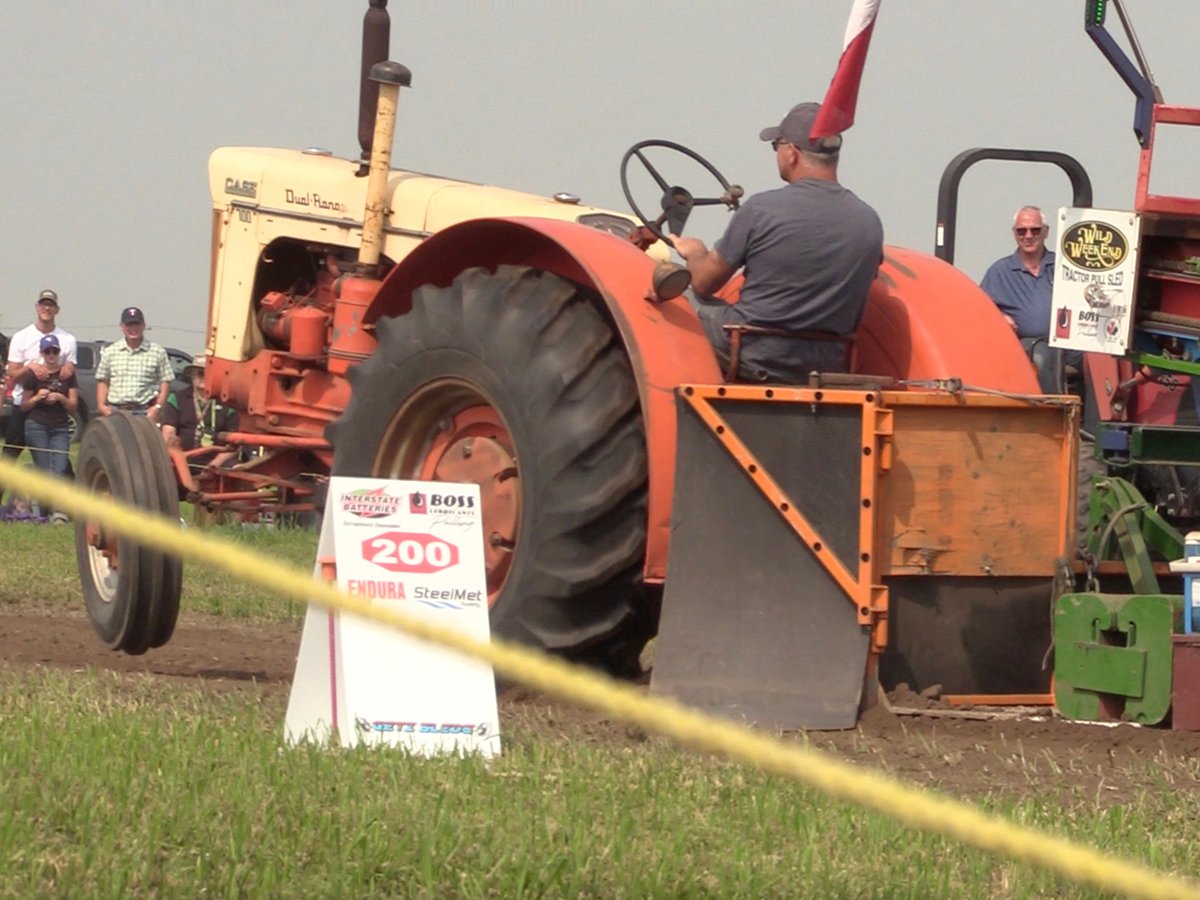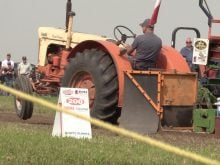A grandson’s hockey game brought back many memories. It was a cold and stormy afternoon when we boarded a chartered bus in Elrose, Sask., to take us to Gull Lake, Sask., for a bantam playoff game. The weather was terrible, storming and cold. However, the decision was made to proceed, so on the bus we got. Grandparents, parents and the team found their seats.
Going on a bus made this game seem more important. Excitement and apprehension were in the air. We made the trip OK even though the bus had to almost stop at times because of the blowing snow. We enjoyed the game, cheering our young heroes on.
Read Also

Vintage power on display at Saskatchewan tractor pull
At the Ag in Motion farm show held earlier this year near Langham, Sask., a vintage tractor pull event drew pretty significant crowds of show goers, who were mostly farmers.
About 30 years ago, we were travelling south to bantam hockey playoffs with our son, instead of our grandson. I fondly remember trips to Herbert and LaFleche, Sask. We parents got so into the games. As I recall we were behind in total point goals in both instances, but managed to win both series. One game in particular had everything happen and we’ve been talking about it ever since.
One of the mothers was watching the game while standing by the boards. It just happened that the linesman, standing inside the boards on the ice, was right in front of her. When our team scored, the poor linesman was surprised by the unexpected great big hug from this mother.
Another mother hollered so loud her false teeth fell out and another got into a dispute with an opposition fan and tugged on his beard. All instances were so out of character for these ladies.
I’ve been contemplating what has changed over 30 years. One difference is that the team is now made up of players from about four different towns. Before, these towns were our opponents.
The result of this is that the distances to travel to games have multiplied. I also didn’t know the players and parents as well as before.
Another difference is the cell phone phenomena. Many parents were in constant touch with family back home by talking on their phones or texting.
Every goal was punched into the phone and sent off. Sending and receiving messages took their attention and eyes away from the game being played. Maybe it was better 30 years ago when there were no cell phone distractions. However, when you are the one left at home, being on the receiving end of these messagesis nice.
Potato rolls
The slight hints of garlic and thyme make these rolls special. This recipe worked well in my two pound bread machine.
11/3 cups water 325 mL
1/4 cup skim milk powder 60 mL
11/2 teaspoons salt 7 mL
1 tablespoon packed brown 15 mL
sugar
2 tablespoons butter 30 mL
3/4 cup mashed potato 175 mL
41/4 cups all-purpose flour 1.06 L
1 teaspoon dried thyme 5 mL
1 clove garlic, minced OR 1 mL
1/4 teaspoon garlic powder
2 teaspoons bread machine yeast 10 mL
Measure ingredients into a bread machine pan in the order recommended by the manufacturer. Insert pan into the oven chamber. Select dough cycle.
When done, remove dough to a lightly floured surface. Cover with a large bowl and let rest for 10 to 15 minutes.
For rolls, divide the dough into 15-18 portions. Roll into balls. Place on a greased baking sheet. Let rise in a warm, draft-free place for about an hour or until doubled in volume. Meanwhile heat oven to 350 F(180 C). Bake in preheated oven for 15-20 minutes or until rolls sound hollow when tapped and are browned.
Cloverleaf rolls
Make as rolls above, but instead of making 15 to 18 rolls, divide the dough into 54 portions and roll into balls. Place three balls in each cup of lightly greased muffin tins. Let rise and bake as above.
Bread loaf
To make this recipe as a loaf, select the two pound (one kg) basic cycle rather than the dough cycle.
Source: 250 Best Canadian Bread Machine Recipes by Donna Washburn and Heather Butt, 2004.
School breakfast program
Dear TEAM: Our school has started a breakfast twice a week for our students called Nutrition for Success. I’m one of the coordinators. I think it is great because kids really learn how important good food is for a happier and healthier person.
Do you have a problem with me posting or copying any of the articles from your column in The Western Producer? I’d love a few more recipes for healthy muffins, although they cannot contain peanuts, nuts or peanut butter since we have a peanut safe school. – B.F. Asquith, Sask.
Dear B.F.: We certainly do not have a problem with you using any of our articles in your program. Nutrition wise, the following muffin recipe has lots going for it with the orange and juice, whole wheat flour rather than white, and the raisins.
Orange raisin muffins
Here is a quick and easy muffin that is mixed in a blender.
It is a recipe submitted to our home economics reunion cookbook by classmate Arlene.
1 orange
1/2 cup orange juice 125 mL
1 egg
1/4 cup oil 60 mL
11/2 cups whole wheat flour 375 mL
3/4 cup sugar 175 mL
1 teaspoon baking powder 5 mL
1 teaspoon baking soda 5 mL
1 teaspoon salt 5 mL
1/2-3/4 cup raisins 125-175 mL
Remove seeds and cut up orange. Place in blender and add the orange juice, egg and oil, blending until smooth. Add the flour, sugar, baking powder, baking soda and salt. Blend. Add raisins and stir to evenly distribute them in the mixture.
Pour mixture into muffin tins lined with large-size baking cups. Bake at 375 F (190 C) for 15-20 minutes.
These muffins freeze well. Makes 12–15 large muffins.
Carrot cookies
I can’t help but include one of our favourite, healthier than most, cookie recipes for your students to enjoy.
1/2 cup margarine 125 mL
1 cup brown sugar 250 mL
2 eggs
1 cup grated carrots 250 mL
1 cup raisins 250 mL
3/4 cup all-purpose flour 175 mL
3/4 cup whole wheat flour 175 mL
2 tsp. baking powder 10 mL
1/4 tsp. baking soda 1 mL
1 tsp. salt 5 mL
1 tsp. cinnamon 5 mL
1 tsp. nutmeg 5 mL
1/2 cup quick-cooking rolled oats 125 mL
Cream margarine with brown sugar. Beat in eggs one at a time, beating well. Stir in carrots and raisins. Gradually add dry ingredients, mixing well.
Drop mixture from tablespoon onto greased baking sheet. Bake in a 350 F (180 C) oven for 15 minutes or until golden brown.
Alma Copeland is a home economist from Elrose, Sask., and one of four columnists comprising Team Resources. Send correspondence in care of this newspaper, Box 2500, Saskatoon, Sask., S7K 2C4 or contact them at team@producer.com.
















